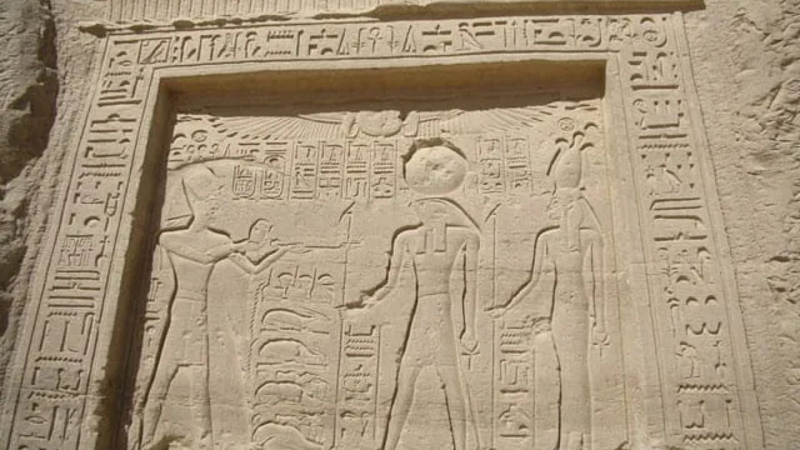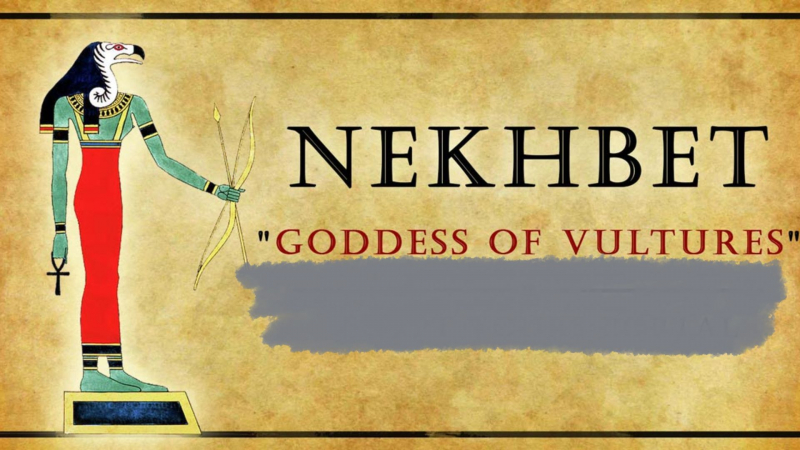Nekhbet - Goddess of Vultures
Nekhbet is a regional deity who first appeared in early predynastic mythology. This goddess was known by the ancient Egyptians as the protector of Nekheb (El Kab). She later rose to become the protector of Upper Egypt. She later rose to the position of the second patron of the united Ancient Egypt. Nekhbet was revered in Egyptian religion as the defender of all the pharaohs of Upper Egypt. The vulture bird stood in for the powerful deity.
Nekhbet is shown in ancient Egyptian art as a winged goddess with her wings spread outward as a sign of protection. A representation of the goddess is a vulture god with extended wings. The white vulture goddess of ancient Egypt is known as the "Mother of Mothers, who has existed from the Beginning." Nekhbet is associated with funeral images and the cult of Osiris in ancient writings. The goddess is thought to have been present when Osiris was born. The pharaoh and the non-royal dead were watched over and safeguarded by Nekhbet. She was frequently pictured as a vulture flapping its wings in front of the subject she was observing. The other made a ground-facing gesture. It stood for the deceased person's defense.
Because Nekhbet was the patron deity of birth, the ancient Egyptians continued to associate her with childbirth. According to certain indicators, she was holding a circular object in her claws. They also portrayed Nekhbet sitting atop a round item. Shen, the round ring, was the name given to this artifact by the ancient Egyptians. According to legend, anything inside the circle was safe for eternity. Furthermore, it represented divine might. Similarly, the lotus or water lily was another image of the deity. It represented Upper Egypt and signified the sun of creation, renewal, and rejuvenation. In Upper Egypt, the goddess's headgear depicted the White Atef crown. Nekhbet, the goddess of the sky, was also associated by the Egyptians with the moon and the sun. When they referred to her as the "Eye of Ra," the ancient Egyptians established this connection.
The White Scavenger Vulture is another name for the vulture that lived in ancient Egypt. The wings of adult vultures have black flying feathers in addition to their white body plumage. White vultures were protected by law because the rulers regarded the birds as royalty. Vultures were revered as great mothers by the ancient Egyptians. Consequently, they decided to use a bird as a symbol for such a significant goddess. As a result, the phrase "Pharaoh's chicken" was created. The ancients also thought that birds could procreate without males because they were all female. White vultures so represented purity. Ancient symbols frequently show Egyptian queens with vulture headdresses, which stood in for Nekhbet.
Nekhbet was originally the goddess of the White Crown, or southern Egypt, represented by a white vulture. Wadjet, on the other hand, was the deity of Lower Egypt's Red Crown in the north. In the future, Lower and Upper Egypt were combined. Nekhbet and Wadjet were paired together by the ancients. The two goddesses were collectively known as the "Two Ladies" by the Egyptians. Additionally, Wadjet and Nekhbet are frequently referred to as the "Two Ladies" in ancient religious Egyptian texts. Wadjet was regarded as a tenacious defender. They also saw Nekhbet as a maternal, gentle, and defender of Egypt. Additionally, an image of the two protective winged goddesses can be seen on the ceilings of a temple in Kom Ombo (Ombus). Wadjet wears the Red Crown (Deshret) of Lower Egypt, whereas Nekhbet dons the White Atef crown.
The goddess is portrayed in Egyptian artwork as the future king's nurse. She frequently tends to the royal infant and breastfeeds him. Nekhbet was also known as the "Mother of Mothers" by the ancient Egyptians since she was the fabled mother of all Egyptian kings. She also guarded the remains of rulers. She assumed the form of a vulture and spread her wings to protect the corpses. In numerous images found in tombs and burial chambers, she is seen as Osiris, the deity of the underworld. She became the most well-known goddess of Egypt due to her connection to the royal family. Furthermore, the monarchs had the Shem, a Nekhbet emblem, engraved on their crowns. They saw it as a symbol of protection and direction. Furthermore, ancient legends suggest that Nekhbet shielded Horus and directed him in his endeavor to recover the throne during the great fight between Horus and Set.
During the New Kingdom period, the strong Mother Goddess Mut absorbed Nekhbet. Mut often donned a regal vulture crown that represents the “Two Ladies”.
The strong goddess guarded the sun god as he traveled over the sky. Another important job of the goddess was to protect Ra from Apep, the snake demon. All of this established Nekhbet as a strong and important goddess. The goddess was associated with protection, childbirth, and fertility by the royals and the people. Her symbols also indicated divine power and protection. In modern culture, the goddess is depicted as a watchful white vulture.












